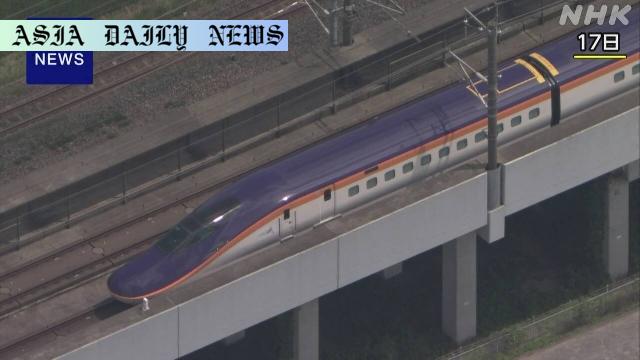Shinkansen trains encountered power supply malfunctions due to damaged semiconductor chips, impacting operations and safety.
Key Point 1: Several Shinkansen trains reported power malfunctions in June.
Key Point 2: Six out of eight power supply units found faulty due to damaged semiconductor components.
Key Point 3: Investigations continue, exploring factors like voltage levels and rising air temperature.

Power Supply Malfunctions in Shinkansen Trains
Recent reports highlight a concerning issue with East Japan Railway’s (JR East) Shinkansen trains. On June 17, four Yamagata Shinkansen E8 series trains experienced significant power supply problems while running through Tochigi and Fukushima prefectures. Each train is equipped with two power supply system units, which are integral to maintaining operational efficiency and safety. Alarmingly, six out of the eight units across these trains showed signs of faulty performance, directly linked to damaged semiconductor chips.
Damaged Semiconductor Chips Identified as a Key Issue
Semiconductor chips play a critical role in the power systems of modern trains, including the Yamagata Shinkansen E8 series. Upon inspection, these components within the power supply system units were found damaged. JR East noted that similar incidents were also reported on May 21 and June 16, raising concerns about the reliability of these trains’ electronic systems. While the root cause remains undetermined, experts suggest that factors such as excessive power voltage, surges in electrical current, or thermal stress due to overheating could have contributed. These vulnerabilities, if unaddressed, could jeopardize the dependability of these high-speed rail systems.
Investigating External Factors and System Risks
JR East, in collaboration with the manufacturers, has launched rigorous investigations into the semiconductor chip malfunctions. Rising air temperatures, which can exacerbate electrical component overheating, are one of the critical external factors being assessed. As global temperatures continue to climb, the influence of environmental conditions on advanced transit systems has become a growing area of concern. In the interim, JR East has prioritized ensuring passenger safety while striving to address these malfunctions promptly. The outcomes of this inquiry could have broader implications for the design and robustness of future Shinkansen models and other transport technologies reliant on similar electrical components.
The Broader Impact on Railway Operations
The disruptions caused by the faulty power supply units underscore the complexities of integrating advanced technologies into public transportation. Shinkansen trains, renowned for their speed and reliability, serve as a vital lifeline connecting various regions in Japan. Power supply malfunctions not only delay transportation schedules but also pose significant operational challenges for railway companies. The damaged semiconductor issues have already attracted attention from industry stakeholders, given the implications for maintenance standards and future design modifications. As customers increasingly expect seamless and reliable travel experiences, addressing these technical setbacks will be crucial in maintaining trust in the Shinkansen brand and rail travel sector overall.
Future Directions and Solutions
To prevent similar incidents in the future, JR East and its partners need to explore enhancing the durability of semiconductor chips and isolating sensitive components from environmental stressors. Implementing better heat dissipating mechanisms, reinforcing voltage regulation systems, and conducting rigorous stress testing in varying environmental conditions are potential measures under review. Furthermore, incorporating real-time diagnostic technologies could help detect early signs of chip degradation, enabling preemptive maintenance. As the Shinkansen system is a flagship feature of Japan’s technological prowess, resolving these challenges promptly is critical to preserving its reputation and ensuring uninterrupted service for passengers.
Commentary
Highlighting the Challenges of Advanced Train Systems
The recent setbacks faced by JR East’s Shinkansen trains underscore the challenges of integrating cutting-edge technology with complex transit systems. While the Shinkansen is globally admired for its innovation and efficiency, incidents like these remind us of the vulnerabilities that even state-of-the-art systems can face. Damaged semiconductor chips, though small in size, are a vital component of modern electronics, and their malfunction can have outsized impacts on operational reliability. The stakes are high when managing such intricate systems, making it imperative to leave no stone unturned during investigations.
Environmental Factors and Technological Robustness
Although JR East has yet to determine a definitive cause for the chip damage, the potential role of rising air temperatures is particularly thought-provoking. The effects of global warming stretch far beyond melting glaciers and extreme weather events—they are now influencing the reliability of infrastructure and technology. Semiconductor chips, being temperature-sensitive, may find themselves at greater risk as mean temperatures climb. This highlights the growing need for designing resilient technologies that can withstand environmental fluctuations while retaining efficiency. The learnings from Shinkansen cases could set a precedent for other industries reliant on similar technologies.
Looking Ahead: Prevention and Progress
In the wake of these malfunctions, JR East faces a dual challenge: restoring public confidence while ensuring long-term system stability. Solutions such as improving thermal management, adopting robust testing procedures, and fostering innovation in material science for chip manufacturing will be instrumental. With Japan’s global reputation as a leader in technological innovation, tackling these obstacles effectively is not merely a corporate responsibility but a matter of national pride. These lessons could spur global advancements in public transportation technology, setting benchmarks for engineering excellence and operational reliability.


